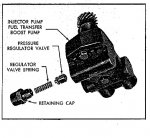Flyingvan911
Well-known member
- 4,709
- 158
- 63
- Location
- Kansas City, MO
The nozzle will leak and let fuel squirt into the intake manifold. No one really knows how the fuel gets into the crankcase but it does. I capped off the two fuel lines going to the nozzle and put a couple of pipe plugs in the nozzle itself.
Look at your intake manifold. You'll see a sparkplug looking thing (igniter) and below it is the nozzle with two fuel lines going in to it.
Look at your intake manifold. You'll see a sparkplug looking thing (igniter) and below it is the nozzle with two fuel lines going in to it.




 Come to think of it, the cover (2 common aka straight tip screws held on a cover) is what sounds like the fuel stop cover. If it is, it was full of fuel when I pulled the cover. That is probably part of the problem.
Come to think of it, the cover (2 common aka straight tip screws held on a cover) is what sounds like the fuel stop cover. If it is, it was full of fuel when I pulled the cover. That is probably part of the problem.